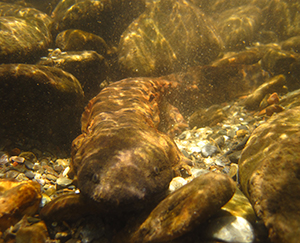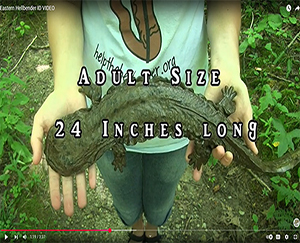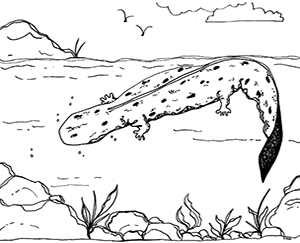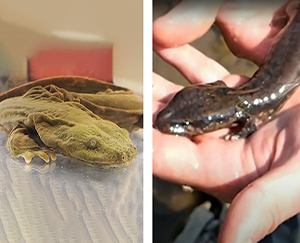What is a hellbender?
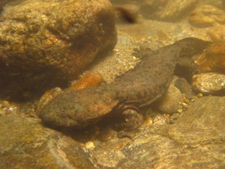 Eastern hellbenders are the largest salamander in North America. Adults are capable of reaching 29 inches in length; however, most individuals are typically 11-24 inches long. This North American giant salamander has short limbs and widely flattened head and body. A fleshy fold of skin extends along the sides of the body between the front and hind limbs giving them an overall wrinkly appearance (Figure 1). Body color is often variable, ranging from a greenish to yellowish brown. Dark spotting is typically present along the back and tail. Although adults are quite large, they are rarely seen. They spend most of their time hiding beneath large, flat rocks during the day and forage for crayfish at night.
Eastern hellbenders are the largest salamander in North America. Adults are capable of reaching 29 inches in length; however, most individuals are typically 11-24 inches long. This North American giant salamander has short limbs and widely flattened head and body. A fleshy fold of skin extends along the sides of the body between the front and hind limbs giving them an overall wrinkly appearance (Figure 1). Body color is often variable, ranging from a greenish to yellowish brown. Dark spotting is typically present along the back and tail. Although adults are quite large, they are rarely seen. They spend most of their time hiding beneath large, flat rocks during the day and forage for crayfish at night.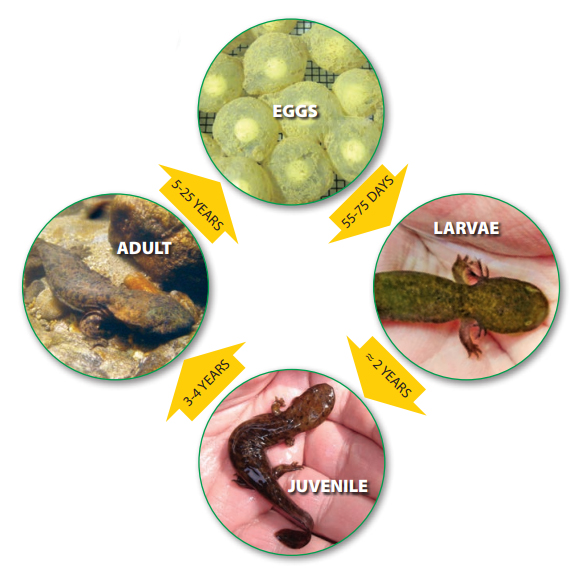
The life cycle of the Eastern Hellbender is a fascinating journey that begins with eggs laid under rocks in clean, flowing streams. From tiny larvae to fully grown adults, each stage depends on healthy aquatic habitats and stable environmental conditions. Understanding this life cycle helps scientists and conservationists protect the species at every step and highlights why preserving stream ecosystems is so important.
Larval hellbenders differ from adults in several ways: they possess external gills, visible yolk sacs, and lack functioning limbs at hatching. Newly hatched larvae are extremely small, generally less than an inch in length. They are typically uniform in color with a dark back and light belly. Larvae will rely on their yolk sacs for nutrition for the first several months of life, before slowly switching to small aquatic invertebrates. The young remain in the larval stage for approximately two years before undergoing a partial transformation.
This transformation changes their physical appearance as well as their behavior. Dorsal spotting begins to form at 6 months (2 to 2.5 inches) and becomes more prominent at one to two years of age (4 to 5 inches) when external gills are lost. The small, transformed juveniles will spend the next few years hiding under small stones in gravel beds. They will require another three to four years to reach sexual maturity.
Hellbenders are long-lived for amphibians, typically living for more than 30 years.
What does a hellbender look like?
More Resources
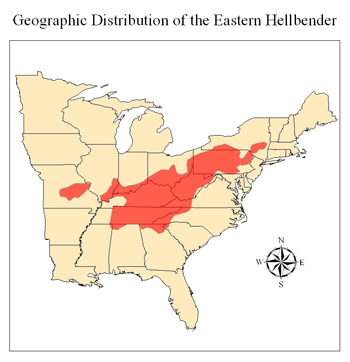 Hellbenders inhabit rivers and streams throughout the eastern United States, including Indiana's Blue River. They require clean, cool, swift-flowing water containing high levels of dissolved oxygen. Because they require high quality water and habitat, their presence can indicate a healthy stream ecosystem.
Hellbenders inhabit rivers and streams throughout the eastern United States, including Indiana's Blue River. They require clean, cool, swift-flowing water containing high levels of dissolved oxygen. Because they require high quality water and habitat, their presence can indicate a healthy stream ecosystem.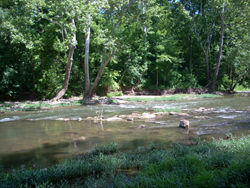 The eastern hellbender has experienced significant declines throughout its geographic range resulting in various levels of protection among state agencies.
The eastern hellbender has experienced significant declines throughout its geographic range resulting in various levels of protection among state agencies.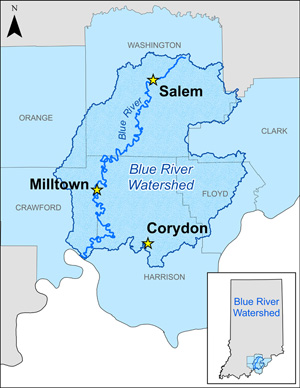 The main stem of the Blue River runs nearly 60 miles before it falls into the Ohio River near Leavenworth. Because much of the flow comes from springs and underground sources, water temperatures remain lower than many other Indiana streams, even during hot summer months. Many of the banks are shaded by large trees, providing additional cooling and structure for fish habitat. The river drops approximately 4 feet per river mile, a gradient that is perfect for canoeists and swift enough to keep many sections relatively free of sediment. The limestone bedrock in the area also provides many crevices for hellbenders and their prey to hide and to thrive. All of these characteristics help provide a suitable living environment for the hellbender.
The main stem of the Blue River runs nearly 60 miles before it falls into the Ohio River near Leavenworth. Because much of the flow comes from springs and underground sources, water temperatures remain lower than many other Indiana streams, even during hot summer months. Many of the banks are shaded by large trees, providing additional cooling and structure for fish habitat. The river drops approximately 4 feet per river mile, a gradient that is perfect for canoeists and swift enough to keep many sections relatively free of sediment. The limestone bedrock in the area also provides many crevices for hellbenders and their prey to hide and to thrive. All of these characteristics help provide a suitable living environment for the hellbender.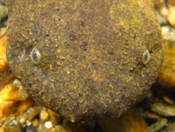 Eastern Hellbenders are aquatic amphibians that spend their entire lives in water. They prefer cool, shallow rivers where rocks are not embedded in sediment or silted in. These conditions exist in many parts of the Blue River
Eastern Hellbenders are aquatic amphibians that spend their entire lives in water. They prefer cool, shallow rivers where rocks are not embedded in sediment or silted in. These conditions exist in many parts of the Blue River
Clean water is important for Hellbenders because they obtain most of their oxygen from the water by “breathing” through their skin. When breathing, their fleshy folds expand in surface area, enabling them to absorb more oxygen from the water.
Adults are typically active at night or on overcast days, and otherwise remain hidden under rocks and other cover. When foraging, hellbenders walk along the bottom searching crevices for prey. Their diet consists almost entirely of crayfish, though they will also eat some small fish and aquatic insects. Hellbenders have small eyes and rely primarily on smell to locate prey.
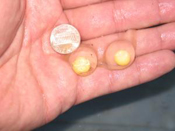 Eastern Hellbenders are one of the few salamander species to externally fertilize eggs. As the female begins to deposit eggs, the male will simultaneously release sperm to fertilize her clutch. Females lay between 100-300 eggs under a male’s nest rock. Individual eggs are attached to each other and have a stringy, beaded appearance resembling a pearl necklace (see the top picture in the diagram below). After egg laying is complete, the male drives off the female and defends the eggs from predators, which include other hellbenders. Eggs hatch into 1-2 inch larvae after 55-75 days. The newly hatched larvae can survive for several months without eating by absorbing nutrients stored in their yolk.
Eastern Hellbenders are one of the few salamander species to externally fertilize eggs. As the female begins to deposit eggs, the male will simultaneously release sperm to fertilize her clutch. Females lay between 100-300 eggs under a male’s nest rock. Individual eggs are attached to each other and have a stringy, beaded appearance resembling a pearl necklace (see the top picture in the diagram below). After egg laying is complete, the male drives off the female and defends the eggs from predators, which include other hellbenders. Eggs hatch into 1-2 inch larvae after 55-75 days. The newly hatched larvae can survive for several months without eating by absorbing nutrients stored in their yolk.
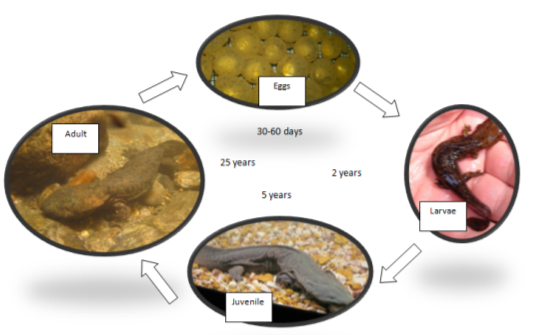 Little is known about the larval life cycle, but they are thought to feed on a variety of aquatic insects and live under gravel and cobble to avoid predators. It is during this larval stage that individuals are the most vulnerable to predation by fish, crayfish, and other aquatic organisms. The larval stage lasts for approximately two years at which point the young undergo a partial transformation. During this life stage, young absorb their gills and begin breathing through their skin. After transformation, juveniles require another three to four years to reach sexual maturity (pictured to the right).
Little is known about the larval life cycle, but they are thought to feed on a variety of aquatic insects and live under gravel and cobble to avoid predators. It is during this larval stage that individuals are the most vulnerable to predation by fish, crayfish, and other aquatic organisms. The larval stage lasts for approximately two years at which point the young undergo a partial transformation. During this life stage, young absorb their gills and begin breathing through their skin. After transformation, juveniles require another three to four years to reach sexual maturity (pictured to the right).
Stay informed and inspired — explore the latest articles and updates on Purdue’s efforts to protect the Eastern Hellbender.
 To request a Hellbender Poster please contact Nicholas Burgmeier, nburgmei@purdue.edu.
To request a Hellbender Poster please contact Nicholas Burgmeier, nburgmei@purdue.edu.
The team is ordering new stickers so check back soon to see if they are available.
 Help Herbie thrive by navigating the river, eating crawfish, and avoiding natural and man-made hazards. Learn about the lifecycle and preservation of the Hellbender Salamander, North America’s largest salamander.
Help Herbie thrive by navigating the river, eating crawfish, and avoiding natural and man-made hazards. Learn about the lifecycle and preservation of the Hellbender Salamander, North America’s largest salamander.
 Hellbenders inhabit rivers and streams throughout the eastern United States, including Indiana's Blue River. They require clean, cool, swift-flowing water containing high levels of dissolved oxygen. Because they require high quality water and habitat, their presence can indicate a healthy stream ecosystem.
Hellbenders inhabit rivers and streams throughout the eastern United States, including Indiana's Blue River. They require clean, cool, swift-flowing water containing high levels of dissolved oxygen. Because they require high quality water and habitat, their presence can indicate a healthy stream ecosystem. The eastern hellbender has experienced significant declines throughout its geographic range resulting in various levels of protection among state agencies.
The eastern hellbender has experienced significant declines throughout its geographic range resulting in various levels of protection among state agencies. The main stem of the Blue River runs nearly 60 miles before it falls into the Ohio River near Leavenworth. Because much of the flow comes from springs and underground sources, water temperatures remain lower than many other Indiana streams, even during hot summer months. Many of the banks are shaded by large trees, providing additional cooling and structure for fish habitat. The river drops approximately 4 feet per river mile, a gradient that is perfect for canoeists and swift enough to keep many sections relatively free of sediment. The limestone bedrock in the area also provides many crevices for hellbenders and their prey to hide and to thrive. All of these characteristics help provide a suitable living environment for the hellbender.
The main stem of the Blue River runs nearly 60 miles before it falls into the Ohio River near Leavenworth. Because much of the flow comes from springs and underground sources, water temperatures remain lower than many other Indiana streams, even during hot summer months. Many of the banks are shaded by large trees, providing additional cooling and structure for fish habitat. The river drops approximately 4 feet per river mile, a gradient that is perfect for canoeists and swift enough to keep many sections relatively free of sediment. The limestone bedrock in the area also provides many crevices for hellbenders and their prey to hide and to thrive. All of these characteristics help provide a suitable living environment for the hellbender. Eastern Hellbenders are aquatic amphibians that spend their entire lives in water. They prefer cool, shallow rivers where rocks are not embedded in sediment or silted in. These conditions exist in many parts of the Blue River
Eastern Hellbenders are aquatic amphibians that spend their entire lives in water. They prefer cool, shallow rivers where rocks are not embedded in sediment or silted in. These conditions exist in many parts of the Blue River
Clean water is important for Hellbenders because they obtain most of their oxygen from the water by “breathing” through their skin. When breathing, their fleshy folds expand in surface area, enabling them to absorb more oxygen from the water.
Adults are typically active at night or on overcast days, and otherwise remain hidden under rocks and other cover. When foraging, hellbenders walk along the bottom searching crevices for prey. Their diet consists almost entirely of crayfish, though they will also eat some small fish and aquatic insects. Hellbenders have small eyes and rely primarily on smell to locate prey.
 Eastern Hellbenders are one of the few salamander species to externally fertilize eggs. As the female begins to deposit eggs, the male will simultaneously release sperm to fertilize her clutch. Females lay between 100-300 eggs under a male’s nest rock. Individual eggs are attached to each other and have a stringy, beaded appearance resembling a pearl necklace (see the top picture in the diagram below). After egg laying is complete, the male drives off the female and defends the eggs from predators, which include other hellbenders. Eggs hatch into 1-2 inch larvae after 55-75 days. The newly hatched larvae can survive for several months without eating by absorbing nutrients stored in their yolk.
Eastern Hellbenders are one of the few salamander species to externally fertilize eggs. As the female begins to deposit eggs, the male will simultaneously release sperm to fertilize her clutch. Females lay between 100-300 eggs under a male’s nest rock. Individual eggs are attached to each other and have a stringy, beaded appearance resembling a pearl necklace (see the top picture in the diagram below). After egg laying is complete, the male drives off the female and defends the eggs from predators, which include other hellbenders. Eggs hatch into 1-2 inch larvae after 55-75 days. The newly hatched larvae can survive for several months without eating by absorbing nutrients stored in their yolk.
 Little is known about the larval life cycle, but they are thought to feed on a variety of aquatic insects and live under gravel and cobble to avoid predators. It is during this larval stage that individuals are the most vulnerable to predation by fish, crayfish, and other aquatic organisms. The larval stage lasts for approximately two years at which point the young undergo a partial transformation. During this life stage, young absorb their gills and begin breathing through their skin. After transformation, juveniles require another three to four years to reach sexual maturity (pictured to the right).
Little is known about the larval life cycle, but they are thought to feed on a variety of aquatic insects and live under gravel and cobble to avoid predators. It is during this larval stage that individuals are the most vulnerable to predation by fish, crayfish, and other aquatic organisms. The larval stage lasts for approximately two years at which point the young undergo a partial transformation. During this life stage, young absorb their gills and begin breathing through their skin. After transformation, juveniles require another three to four years to reach sexual maturity (pictured to the right).
Stay informed and inspired — explore the latest articles and updates on Purdue’s efforts to protect the Eastern Hellbender.
 To request a Hellbender Poster please contact Nicholas Burgmeier, nburgmei@purdue.edu.
To request a Hellbender Poster please contact Nicholas Burgmeier, nburgmei@purdue.edu.
The team is ordering new stickers so check back soon to see if they are available.
 Help Herbie thrive by navigating the river, eating crawfish, and avoiding natural and man-made hazards. Learn about the lifecycle and preservation of the Hellbender Salamander, North America’s largest salamander.
Help Herbie thrive by navigating the river, eating crawfish, and avoiding natural and man-made hazards. Learn about the lifecycle and preservation of the Hellbender Salamander, North America’s largest salamander.
